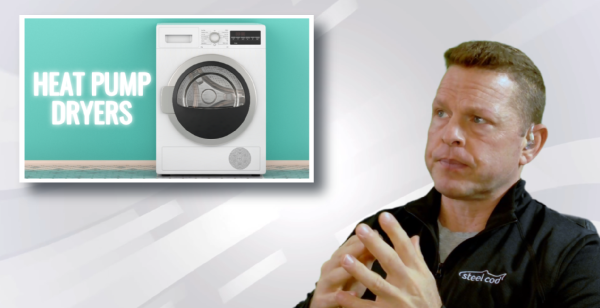Heat Pump Dryers
The Future of Drying or Just Hype?
Heat Pump Dryers
Most customers don’t know what a heat pump dryer is — let alone why it could be a game-changer for efficiency, fabric care, and energy savings. If you’re not selling them, you’re missing out. We’ll show you exactly how they work and how to make customers see their value — fast.
Heat Pump Dryers
Is the water captured in the closed-loop system of a heat pump dryer actually potable? Find out as Jon, Anthony and Tom discuss that and more in this week's review of heat pump dryers! (Spoiler: it's not potable! Don't drink it!)
Documentation
Recap
Key Questions & Answers
Why don’t more customers ask about heat pump dryers?
Lack of awareness — many don’t know they exist. As energy efficiency becomes a priority, adoption is increasing.
Are heat pump dryers just a niche product, or is demand growing?
Energy-efficient appliance sales are up 20% in three years. More customers are prioritizing lower bills, quieter operation, and fabric care.
How do I convince hesitant customers that the higher upfront cost is worth it?
Lower energy bills, better fabric care, and longer lifespan offset the initial investment—saving money over time.
Do lower operating temperatures mean longer drying times?
Some cycles are longer, but precise moisture sensors prevent overdrying. Clothes last longer, saving money on replacements.
Why haven’t heat pump dryers completely replaced traditional dryers?
Upfront cost is a factor, but like LED bulbs vs. incandescent, market adoption is growing as benefits become clear.
How do I reassure customers who don’t trust new technology?
Proven for over a decade in Europe. Uses the same heat recycling technology found in refrigerators and air conditioners.
Are heat pump dryers complicated to use?
No — same operation as a traditional dryer. Features like auto-sensing cycles simplify the process.
Do customers need to change laundry habits?
No major changes. Balanced loads improve airflow, and some models require occasional emptying of a water reservoir.
What are the downsides of heat pump dryers?
Higher upfront cost, longer cycles, and minor maintenance like filter cleaning — but no vent cleaning needed.
What are the most common installation challenges?
Ensure 2-3 inches of airflow clearance. Some models need a drain hookup or manual condensation tank emptying.
Do heat pump dryers require more maintenance?
Different, not more. Filters need periodic cleaning, but fewer issues from high heat wear and tear.
Are there households where heat pump dryers might not be ideal?
Large families running multiple loads may prefer hybrid models for faster drying.
How much energy do heat pump dryers save?
Use 30-50% less energy than traditional dryers. Average savings of $140-$200 per year in electricity costs.
Can they be stacked or placed in closets?
Yes, but require ventilation clearance (typically 2-3” around the unit). Stacking kits are available.
Are there ventilation or clearance requirements for custom installations?
No external venting needed, but ensure 2” of clearance on sides and 4” behind for heat dissipation.

